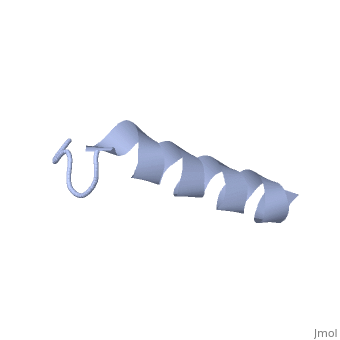1lbj
From Proteopedia
NMR solution structure of motilin in phospholipid bicellar solution
Structural highlights
FunctionMOTI_HUMAN Plays an important role in the regulation of interdigestive gastrointestinal motility and indirectly causes rhythmic contraction of duodenal and colonic smooth muscle. Publication Abstract from PubMedThe structure and dynamics of the gastrointestinal peptide hormone motilin, consisting of 22 amino acid residues, have been studied in the presence of isotropic q = 0.5 phospholipid bicelles. The NMR solution structure of the peptide in acidic bicelle solution was determined from 203 NOE-derived distance constraints and six backbone torsion angle constraints. Dynamic properties for the 13Calpha-1H vector in Leu10 were determined for motilin specifically labeled with 13C at this position by analysis of multiple-field relaxation data. The structure reveals an ordered alpha-helical conformation between Glu9 and Lys20. The N-terminus is also well structured with a turn resembling that of a classical beta-turn. The 13C dynamics clearly show that motilin tumbles slowly in solution, with a correlation time characteristic of a large object. It was also found that motilin has a large degree of local flexibility as compared with what has previously been reported in SDS micelles. The results show that motilin interacts with the bicelle, displaying motional properties of a peptide bound to a membrane. In comparison, motilin in neutral bicelles seems less structured and more flexible. This study shows that the small isotropic bicelles are well suited for use as membrane-mimetic for structural as well as dynamical investigations of membrane-bound peptides by high-resolution NMR. NMR solution structure and dynamics of motilin in isotropic phospholipid bicellar solution.,Andersson A, Maler L J Biomol NMR. 2002 Oct;24(2):103-12. PMID:12495026[1] From MEDLINE®/PubMed®, a database of the U.S. National Library of Medicine. See AlsoReferences
| ||||||||||||||||||

